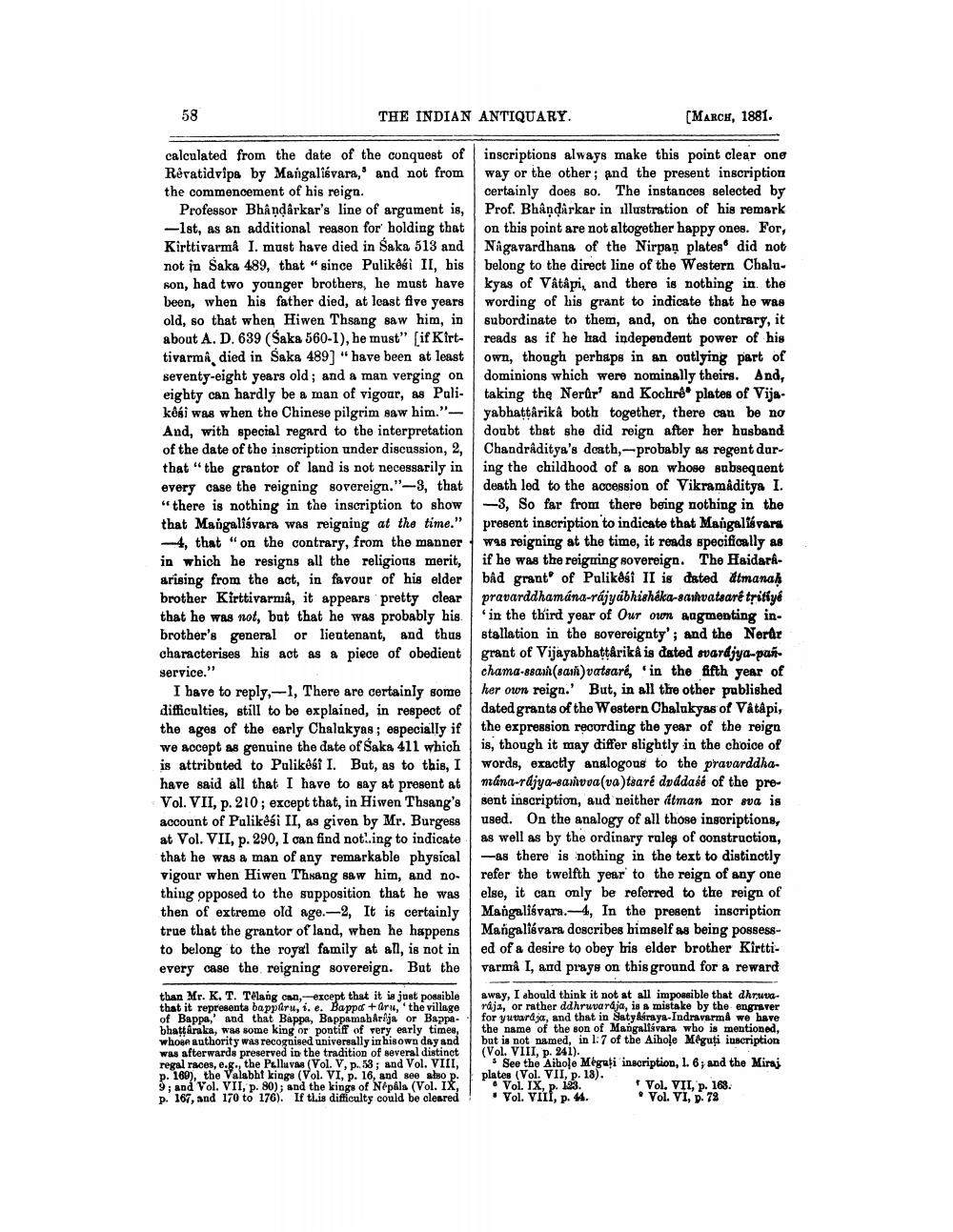________________
58
THE INDIAN ANTIQUARY.
(MARCH, 1881.
calculated from the date of the conquest of Rératidvipa by Mangaliśvara,' and not from the commencement of his reign.
Professor Bhåndarkar's line of argument is, - 1st, as an additional reason for holding that Kirttivarmå I. must have died in Saka 513 and not in Saka 489, that "since Pulikasi II, bis Ron, had two younger brothers, he must have been, when his father died, at least five years old, so that when Hiwen Thsang saw him, in about A. D. 639 (Saka 560-1), he must" (if Kirttivarma, died in Saka 489] " have been at least seventy-eight years old ; and a man verging on eighty can hardly be a man of vigour, as Paliköhi was when the Chinese pilgrim saw him."And, with special regard to the interpretation of the date of the inscription under discussion, 2, that "the grantor of land is not necessarily in every case the reigning sovereign."-3, that "there is nothing in the inscription to show that Mangaliśvara was reigning at the time." -4, that "on the contrary, from the manner in which he resigns all the religions merit, arising from the act, in favour of his elder brother Kirttivarmâ, it appears pretty clear that he was not, but that he was probably his. brother's general or lieutenant, and thus characterises his act as a piece of obedient service."
I have to reply,--1, There are certainly some difficulties, still to be explained, in respect of the ages of the early Chalukyas ; especially if we accept as genuine the date of Saka 411 which is attributed to Pulikasi I. But, as to this, I have said all that I have to say at present at Vol. VII, p. 210; except that, in Hiwen Thsang's account of Palikasi II, as given by Mr. Burgess at Vol. VII, p. 290, I can find not.ing to indicate that he was a man of any remarkable physical vigour when Hiwen Thsang saw him, and no. thing opposed to the supposition that he was then of extreme old age.-2, It is certainly true that the grantor of land, when he happens to belong to the royal family at all, is not in every case the reigning sovereign. But the
inscriptions always make this point clear one way or the other; and the present inscription certainly does so. The instances selected by Prof. Bhåndarkar in illustration of his remark on this point are not altogether happy ones. For, Nagavardhana of the Nirpan plates did not belong to the direct line of the Western Chalukyas of Vâtâpi, and there is nothing in the wording of his grant to indicate that he was subordinate to them, and, on the contrary, it reads as if he had independent power of his own, though perhaps in an outlying part of dominions which were nominally theirs. And, taking the Nerûr' and Kochre plates of Vijayabhattårikå both together, there can be no doubt that she did reign after her husband Chandråditya's death, - probably as regent during the childhood of a son whose subsequent death led to the accession of Vikramaditya I.
-3, So far from there being nothing in the present inscription to indicate that Mangaliávars W48 reigning at the time, it reads specifically as if he was the reigning sovereign. The Haidardbåd grant of Palikesi II is dated atmanah pravarddhamána-rájyábhisheka-samvatsaré tritiye
in the third year of our own augmenting installation in the sovereignty'; and the Nerar grant of Vijayabhattårikå is dated svardjya-panchama-88ax(sain)vatsaré, 'in the fifth year of her own reign.' But, in all the other published dated grants of the Western Chalukyas of Våtâpi, the expression recording the year of the reign is, though it may differ slightly in the choice of words, exactly analogous to the pravarddhamána-rdjya-saxvoa(va)tsaré dvddase of the pregent inscription, aud neither itman nor sva is used. On the analogy of all those inscriptions, as well as by the ordinary rules of construction, -as there is nothing in the text to distinctly refer the twelfth year to the reign of any one else, it can only be referred to the reign of Mangaliśvara.-4, In the present inscription Mangaliśvara describes himself as being possessed of a desire to obey his elder brother Kirttivarma I, and praye on this ground for a reward
than Mr. K. T. Telang can, except that it is just possible that it representa bapparu, i. e. Bappa + ar14, the village of Bappa,' and that Bappa, Bappamah Arija or Bappabhattaraka, Was some king or pontiff of very early times, whoan authority was recognised universally in hisown day and was afterwards preserved in the tradition of several distinct regal races, e.g., the Pulluvas (Vol. V, p. 53; and Vol. VIII, p. 169), the Valabht kings (Vol. VI, p. 16, and see also p. 9; and Vol. VII, p. 80); and the kings of Nepála (Vol. IX, p. 167, and 170 to 176). If this difficulty could be cleared
away, I should think it not at all impossible that dhruua. rája, or rather ddhruvaraja, is & mistake by the engraver for yuvardja, and that in daty dýraya-Indravarmi we have the name of the son of Mangaliśvara who is mentioned, but is not named, in 1: 7 of the Aihole Méguți inscription (Vol. VIII, p. 941).
See the Aihole Mégati inscription, 1. 6; and the Miraj plates (Vol. VII, p. 18). o Vol. IX, p. 193.
Vol. VII, p. 168. Yol. VIII, p. 44.
• Vol. VI, p. 72




